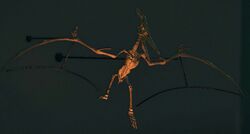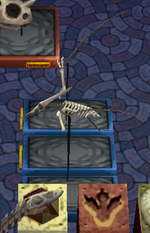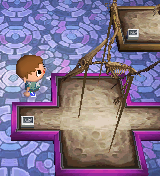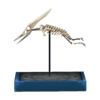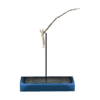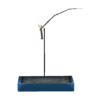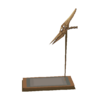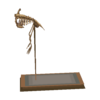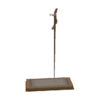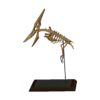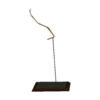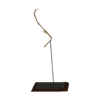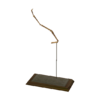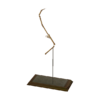Pteranodon
The Pteranodon is a multi-part fossil in the Animal Crossing series introduced in Doubutsu no Mori that appears in all subsequent games to date. It is a three-part fossil in all games except Animal Crossing: Wild World, with a body (named skull prior to New Horizons), left wing, and right wing. In Wild World, the body and skull are split, making it a four-part fossil.
At the museum[edit]
In Animal Crossing[edit]
When donating the final part to Blathers in Animal Crossing, he will provide the following information about the fossil: When the player donates to Blathers in Animal Crossing, he will provide the following information about the Pteranodon:
In Wild World[edit]
When donating to Blathers in Wild World, he will provide the following information about the fossil: When donating to Blathers in Wild World, he will provide the following information about the Pteranodon:
The Pteranodon can be found in the second room of the fossil exhibit in the museum. Its plaque reads:
"Pteranodon
Length: 30.2 feet
Late Cretaceous"
In City Folk[edit]
The Pteranodon can be found in the second room of the fossil exhibit in the museum. Its plaque reads:
"Pteranodon
Length: 30.2 feet
Late Cretaceous Period"
In New Leaf[edit]
After completing the fossil in New Leaf, its plaque in the museum will read:
"Pteranodons were a type of winged reptile, perhaps the ancestors of common birds. With their wings spread, they were about the size of a small airplane, but their bodies were very light. Strangely, they weighed less than 50 pounds, with wings made from skin, allowing for ease of flight."
The Pteranodon can be found in the left room of the fossil exhibit in the museum.
In New Horizons[edit]
When the player donates to Blathers or selects "Tell me about this!" in New Horizons, he will provide the following information about the fossil:
The Pteranodon can be found in the second room of the fossil exhibit in the museum.
As an item[edit]
In Animal Crossing[edit]
| Ptera skull | |
|---|---|
| Sell price | |
| Size | |
| Ptera right wing | |
|---|---|
| Sell price | |
| Size | |
| Ptera left wing | |
|---|---|
| Sell price | |
| Size | |
In Wild World[edit]
| Ptera skull | |
|---|---|
| Sell price | |
| Colors | Brown
Brown
|
| HRA genre | Old-school |
| Size | |
| Ptera body | |
|---|---|
| Sell price | |
| Colors | Brown
Brown
|
| HRA genre | Old-school |
| Size | |
| Ptera left wing | |
|---|---|
| Sell price | |
| Colors | Brown
Brown
|
| HRA genre | Old-school |
| Size | |
| Ptera right wing | |
|---|---|
| Sell price | |
| Colors | Brown
Brown
|
| HRA genre | Old-school |
| Size | |
In City Folk[edit]
| Ptera skull | |
|---|---|
| Sell price | |
| Colors | Brown
Brown
|
| HRA genre | Retro |
| Size | |
| Ptera left wing | |
|---|---|
| Sell price | |
| Colors | Brown
Brown
|
| HRA genre | Retro |
| Size | |
| Ptera right wing | |
|---|---|
| Sell price | |
| Colors | Brown
Brown
|
| HRA genre | Retro |
| Size | |
In New Leaf[edit]
| Ptera skull | |
|---|---|
| Sell price | |
| Colors | Brown
Brown
|
| Style | Historical |
| HHA theme challenge | Quirky |
| Size | |
| Ptera left wing | |
|---|---|
| Sell price | |
| Colors | Brown
Brown
|
| Style | Historical |
| HHA theme challenge | Quirky |
| Size | |
| Ptera right wing | |
|---|---|
| Sell price | |
| Colors | Brown
Brown
|
| Style | Historical |
| HHA theme challenge | Quirky |
| Size | |
In New Horizons[edit]
| Ptera body | |
|---|---|
| Interactable | No |
| Sell price | |
| Colors | Brown
Brown
|
| Size | |
| Right ptera wing | |
|---|---|
| Interactable | No |
| Sell price | |
| Colors | Brown
Brown
|
| Size | |
| Left ptera wing | |
|---|---|
| Interactable | No |
| Sell price | |
| Colors | Brown
Brown
|
| Size | |
Real-world information[edit]
Pteranodon was a pterosaur which lived 86–84.5 million years ago around the Western Interior Seaway, a shallow sea that stretched down the middle of modern-day North America. Around 1,200 specimens of Pteranodon have been found, more than any other pterosaur. Males had an average wingspan of 5.6 meters, while females averaged 3.8 meters. They were known to have been piscivores, or fish-eaters. In the past, it was believed they could not take off from the water and would have skimmed the surface with its toothless beak (from which it gets its name) while flying. However, more recent studies suggest that not only were they able to land and take off from the water's surface, but they may also have been able to dive for fish.
More information on this topic is available at Wikipedia.
| Fossils | ||||||||||||||||||||||||
|---|---|---|---|---|---|---|---|---|---|---|---|---|---|---|---|---|---|---|---|---|---|---|---|---|
| ||||||||||||||||||||||||
